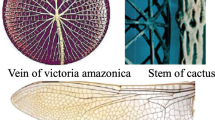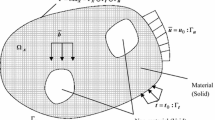Abstract
The lightweight and high efficiency of natural structures are the inexhaustible sources for engineering improvements. The goal of the study is to find innovative solutions for mechanical lightweight design through the application of structural bionic approaches. Giant waterlily leaf ribs and cactus stem are investigated for their optimal framework and superior performance. Their structural characteristics are extracted and used in the bio-inspired design of Lin MC6000 gantry machining center crossbeam. By mimicking analogous network structure, the bionic model is established, which has better load-carrying capacity than conventional distribution. Finite Element Method (FEM) is used for numerical simulation. Results show better specific stiffness of the bionic model, which is increased by 17.36%. Finally the scaled models are fabricated by precision casting for static and dynamic tests. The physical experiments are compared to numerical simulation. The results show that the maximum static deformation of the bionic model is reduced by about 16.22%, with 3.31% weight reduction. In addition, the first four natural frequencies are improved obviously. The structural bionic design is a valuable reference for updating conventional mechanical structures with better performance and less material consumption.
Similar content being viewed by others
References
Ren L Q, Liang Y H. Biological couplings: Function, characteristics and implementation mode. Science in China Series E: Technological Sciences, 2010, 53, 379–387.
Chen P Y, Lin A Y M, Lin Y S, Seki Y, Stokes A G, Peyras J, Olevsky E A, Meyers M A, McKittrick J. Structure and mechanical properties of selected biological materials. Journal of the Mechanical Behavior of Biomedical Materials, 2008, 1, 208–226.
Junior W K, Guanabara A S. Methodology for product design based on the study of bionics. Materials and Design, 2005, 26, 149–155.
Ma J F, Chen W Y, Zhao L, Zhao D H. Elastic buckling of bionic cylindrical shells based on bamboo. Journal of Bionic Engineering, 2008, 5, 231–238.
Kim D I, Jung S C, Lee J E, Chang S H. Parametric study on design of composite-foam-resin concrete sandwich structures for precision machine tool structures. Composite Structures, 2006, 75, 408–414.
Ding X H, Li G J, Zhang Z J. A mechanics study on adaptiveness of biological morphologies and structure and its applications. Advances in mechanics, 2006, 36, 103–110. (in Chinese)
Milwich M, Speck T, Speck O, Stegmaier T, Planck H. Biomimetics and technical textiles: solving engineering problems with the help of nature’s wisdom. American Journal of Botany, 2006, 93, 1455–1465.
Pflug J, Fan X Y, Vangrimde B, Verpoest I. Development of a sandwich material with polypropylene/natural fibre skins and paper honeycomb core. 10th European Conference on Composite Materials, Brugge, Belgium, 2002, 331–336.
Ma J F, Chen W Y, Zhao L, Zhao D H. Bionic design of aircraft reinforced frame based on structure of dragonfly wing. Acta Aeronautica ET Astronautica Sinica, 2009, 30, 562–569. (in Chinese)
Zhao L, Chen W Y, Ma J F, Yang Y B. Structural bionic design and experimental verification of a machine tool column. Journal of Bionic Engineering, 2008, 5, S46–S52.
Jiao H J, Zhang Y D, Chen W Y. The lightweight design of low RCS pylon based on structural bionics. Journal of Bionic Engineering, 2010, 7, 182–190.
Gim T, Lee C H, Ha J Y, Kim T H. Machine tool technologies for high performance machines. International Conference on Smart Manufacturing Application. Gyeonggi-do, Korea, 2008, 230–233.
Zhang Y C, Ma Z Y. Mechanical Procesing Handbook, Aviation Industry Press, Beijing, 1993. (in Chinese)
Bohn S, Andreotti B, Douady S, Munzinger J, Couder Y. Constitutive property of the local organization of leaf venation networks. Physical Review E, 2002, 65, 061914.
Huang D T Y, Lee J J. On obtaining machine tool stiffness by CAE techniques. International Journal of Machine Tools and Manufacture, 2001, 41, 1149–1163.
Author information
Authors and Affiliations
Corresponding author
Rights and permissions
About this article
Cite this article
Zhao, L., Ma, J., Chen, W. et al. Lightweight design and verification of gantry machining center crossbeam based on structural bionics. J Bionic Eng 8, 201–206 (2011). https://doi.org/10.1016/S1672-6529(11)60021-8
Published:
Issue Date:
DOI: https://doi.org/10.1016/S1672-6529(11)60021-8




